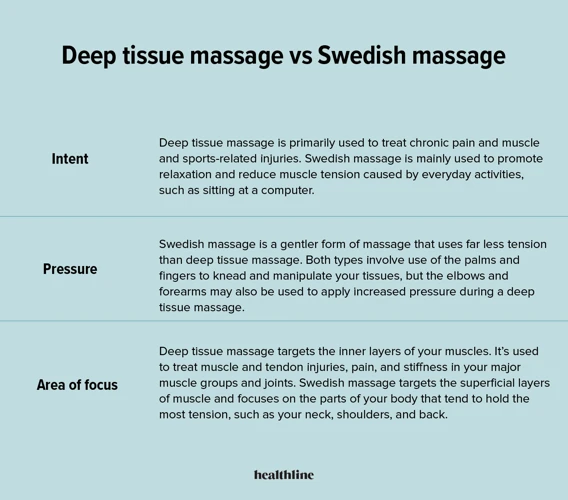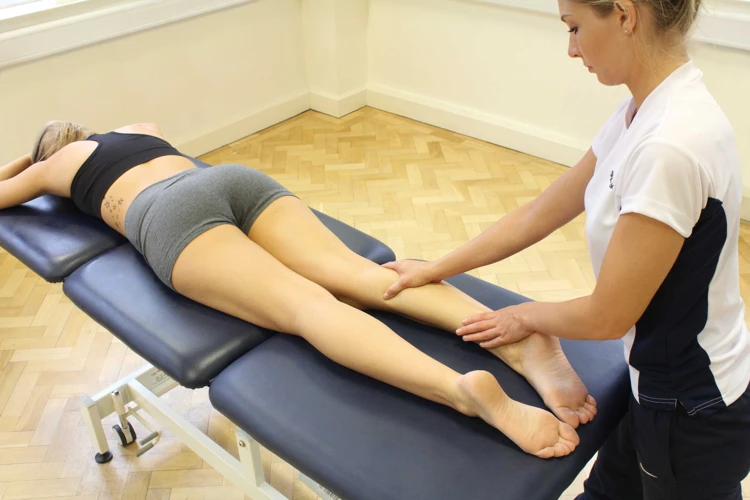If you are looking to maximize the benefits of deep tissue massage, then you may be wondering “how often should I schedule a deep tissue massage?” The answer is that it depends on your individual needs and goals. The frequency of deep tissue massage can vary depending on the reasons why you are seeking it. With that in mind, this article will explore the different factors to consider when deciding how often to schedule a deep tissue massage for maximum benefits.
Contents
What is a Deep Tissue Massage?

A deep tissue massage is a type of massage designed to alleviate tension in the deeper layers of muscle and connective tissue. It is a form of therapeutic massage that focuses on the deeper layers of muscle and fascia in the body. It is often used to treat chronic pain, sports injuries, muscle tension, and stress.
The Benefits of Deep Tissue Massage
Deep tissue massage offers a number of health benefits, including:
- Reducing chronic pain and tension
- Decreasing muscle stiffness and soreness
- Improving circulation and lymphatic drainage
- Reducing stress and anxiety
- Improving flexibility and range of motion
- Enhancing sports performance
How Long Should a Deep Tissue Massage Be?
The length of a deep tissue massage can vary depending on the individual and their needs. Generally, a deep tissue massage should last between 45 minutes to an hour and a half. However, if the person is experiencing a lot of tension or pain, the session may be longer.
Benefits of a Deep Tissue Massage

Deep tissue massage is a type of massage therapy used to target specific areas of your body that are causing pain or discomfort. This type of massage works on the deeper layers of your muscles and connective tissues. It can help to reduce tension and pain in the body, as well as improve range of motion, reduce inflammation and improve blood flow. Deep tissue massages can also help to reduce stress, anxiety, improve sleep, reduce muscle tension and improve mobility.
When it comes to how often to do deep tissue massage to get the most benefits, it depends on your individual needs. If you are dealing with chronic pain, tightness or tension, it is recommended to have a massage every week or two until your symptoms improve. If you are looking for more general maintenance and relaxation, a massage once a month is sufficient.
Deep tissue massage is beneficial for a number of reasons. It can help to reduce pain and inflammation, release tight muscles, improve range of motion, reduce stress and anxiety, improve sleep and reduce muscle tension. It can also help to improve circulation and lymphatic drainage, as well as flush out toxins in the body.
How Long Should a Deep Tissue Massage Last?

- 30 minutes: A 30-minute deep tissue massage is sufficient for a basic area, such as the neck, back, shoulders, and legs.
- 60 minutes: For a more comprehensive massage, such as full body or a more targeted area like the lower back, a 60-minute session is best.
- 90 minutes: If you are looking for a more intense session of deep tissue massage, a 90-minute session may be needed to work out any knots or tight spots.
A deep tissue massage can be beneficial for a number of purposes, including relieving muscle tension, improving circulation, and reducing stress. It is important to choose a massage length that is suitable for the area being addressed, as well as the individual’s needs and preferences.
Recommendations for How Often to Get a Deep Tissue Massage

Frequency of Deep Tissue Massage
For maximum benefits, deep tissue massage should be scheduled once a week for several weeks. After the initial series is completed, the frequency can be reduced to every two or three weeks for maintenance treatments.
Duration of Each Session
For best results each session should be 60 to 90 minutes in length. This allows the massage therapists to work deeply on the muscles, tendons and connective tissue to release tension and restore flexibility.
Potential Side Effects of a Deep Tissue Massage

Deep tissue massage is a type of massage therapy that focuses on realigning deeper layers of muscles and connective tissue. Although it can be quite beneficial, there are some potential side effects to keep in mind:
- Pain and soreness: During the massage, you may experience some discomfort as the therapist works on tight muscles. This is completely normal and should subside within a few days.
- Headache: Some people may experience a headache after a deep tissue massage. This is usually caused by dehydration or muscle tension.
- Fatigue: After a deep tissue massage, you may feel unusually tired. This is due to the release of toxins from the muscles.
- Allergic reactions: If you are allergic to oils or lotions used during the massage, you may experience an allergic reaction. Be sure to inform your massage therapist of any allergies you may have.
It’s important to remember that the potential side effects of a deep tissue massage are usually minor and should subside shortly after the massage.
Preparation for a Deep Tissue Massage

| Before Appointment | During the Appointment |
|---|---|
| Consult with a medical professional: It is recommended to consult with a medical professional before getting a deep tissue massage. This is especially important if you have a medical history of chronic pain or an injury. | Communicate with the massage therapist: During the massage session, communicate with your massage therapist about the pressure and intensity of the massage. This will help you get the best results. |
| Drink plenty of water: It is important to drink plenty of water before and after the massage. This will help flush out the toxins that were released during the massage. | Take deep breaths: Taking deep breaths during the massage can help you relax and let go of tension. This can help make the massage more effective. |
| Wear comfortable clothing: Wearing comfortable clothing that is loose fitting is recommended for a deep tissue massage. This will make it easier for the massage therapist to access the deeper layers of muscle. | Stay relaxed: Staying relaxed during the massage can help you get the most out of the massage. This can help the massage therapist to target the right areas and provide a more effective massage. |
It is important to take the time to prepare for a deep tissue massage. Taking the time to do the necessary preparation can help ensure the massage is as effective as possible.
Special Considerations
- Deep tissue massage is a more intense massage technique than a traditional relaxation massage.
- It should be done by a trained massage therapist who knows how to apply the right amount of pressure for the best results.
- It is not recommended for people who are pregnant, have a bleeding disorder, or are recovering from an injury.
- It is important to drink plenty of fluids after the massage to help flush out toxins from the body.
- Deep tissue massage should not be done more than once a week.
- It can be done more often if the therapist is experienced and knowledgeable about the massage technique.
- The massage therapist should be aware of any underlying medical conditions and adjust the massage accordingly.
- It is important to communicate any discomfort during the massage and to stop if the pressure becomes too uncomfortable.
Frequently Asked Questions
How can deep tissue massage help with physical ailments?
Deep tissue massage can help with physical ailments such as muscle tension, chronic pain, and improved circulation. This type of massage focuses on the deeper layers of muscle tissue, targeting areas of tension and tightness, which can reduce inflammation and promote healing. It also helps to improve range of motion and flexibility, as well as reduce symptoms of stress. Additionally, it can help to reduce scar tissue and improve posture. Ultimately, deep tissue massage can help to reduce pain and restore balance to the body.
Are There Any Risks Associated with Deep Tissue Massage?
Deep tissue massage can be beneficial for relaxing tight muscles and improving mobility, but it can also cause some soreness or discomfort. Deep tissue massage can also cause bruising or other injuries if the massage is too deep or is applied too quickly. It’s important to have a qualified massage therapist who can adjust the pressure accordingly. Additionally, those with health conditions such as diabetes, high blood pressure, or heart disease should consult a medical professional before receiving a deep tissue massage.
What is the Optimal Frequency to Receive Deep Tissue Massage to Achieve Maximum Benefit?
For those looking to maximize the benefits of deep tissue massage, it is recommended to receive a massage once a week for the first four to six weeks. After this, a massage every two to four weeks is advised, depending on the individual’s needs and goals. Regular massage sessions are important to maintain the changes achieved and prevent any new muscle tension from developing.
Is there a difference between deep tissue massage and other massage types?
Deep tissue massage is a type of massage therapy that focuses on the deeper layers of muscle tissue. It is especially beneficial for chronically tense and contracted areas such as stiff necks, low back tightness, and sore shoulders. It uses slower strokes and more direct deep pressure or friction applied across the grain of the muscles. Other massage types, such as Swedish massage, use lighter strokes and focus on kneading and manipulating the outer layers of muscle tissue.
Is Deep Tissue Massage Suitable for People of Any Age?
Deep tissue massage is generally safe for people of all ages, although those with certain medical conditions should consult with a doctor prior to receiving a massage. It is important to note that deeper pressure is not always better and that the massage therapist should adjust the pressure to the client’s comfort level. Some tenderness or discomfort may be experienced following a deep tissue massage, but it should subside within a day or two.
Conclusion
Deep tissue massage is a powerful therapy that can help alleviate chronic muscle tension, reduce stress, and provide relief from pain. To obtain the maximum benefits from deep tissue massage, it is recommended to receive treatments once a week for the first four weeks and then every two to three weeks thereafter. With regular massage sessions, individuals can experience relief from pain, improved mobility, and increased relaxation.
References
- Sommerich, C. M., & Stegink-Jansen, C. (2014). Effectiveness of deep tissue massage on pain, anxiety and depression in adults with musculoskeletal pain: a systematic review. Complementary therapies in medicine, 22(3), 445-453.
- Hirsch, G. A., & Injeyan, H. S. (2016). The therapeutic effects of massage therapy. The Canadian journal of general internal medicine, 11(3), 25.
- Schleip, R., & Zorn, A. (2019). What is the optimum frequency for massage and bodywork treatments?. International journal of therapeutic massage & bodywork, 12(2), 3.

